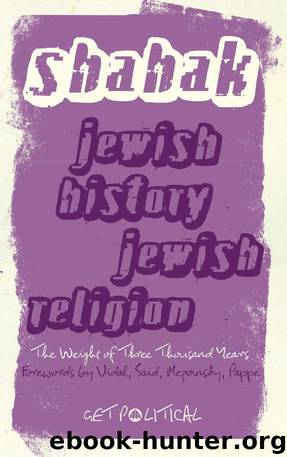Jewish History, Jewish Religion. The Weight of Three Thousand Years by Israel Shahak

Author:Israel Shahak [Shahak, Israel]
Language: eng
Format: epub, mobi
Tags: Non fiction
Published: 2015-02-28T23:00:00+00:00
Major Features of Classical Judaism
Let us therefore ignore those ‘dark ages’, and for the sake of convenience begin with the two centuries 1000-1200, for which abundant information is available from both internal and external sources on all the important Jewish centers, east and west. Classical Judaism, which is clearly discernible in this period, has undergone very few changes since then, and (in the guise of Orthodox Judaism) is still a powerful force today.
How can that classical Judaism be characterized, and what are the social differences distinguishing it from earlier phases of Judaism? I believe that there are three such major features.
1. Classical Jewish society has no peasants, and in this it differs profoundly from earlier Jewish societies in the two centers, Palestine and Mesopotamia. It is difficult for us, in modern times, to understand what this means. We have to make an effort to imagine what serfdom was like; the enormous difference in literacy, let alone education, between village and town throughout this period; the incomparably greater freedom enjoyed by all the small minority who were not peasants – in order to realize that during the whole of the classical period the Jews, in spite of all the persecutions to which they were subjected, formed an integral part of the privileged classes. Jewish historiography, especially in English, is misleading on this point inasmuch as it tends to focus on Jewish poverty and anti-Jewish discrimination. Both were real enough at times; but the poorest Jewish craftsman, peddler, land-lord’s steward or petty cleric was immeasurably better off than a serf. This was particularly true in those European countries where serfdom persisted into the 19th century, whether in a partial or extreme form: Prussia, Austria (including Hungary), Poland and the Polish lands taken by Russia. And it is not without significance that, prior to the beginning of the great Jewish migration of modern times (around 1880), a large majority of all Jews were living in those areas and that their most important social function there was to mediate the oppression of the peasants on behalf of the nobility and the Crown.
Everywhere, classical Judaism developed hatred and contempt for agriculture as an occupation and for peasants as a class, even more than for other Gentiles – a hatred of which I know no parallel in other societies. This is immediately apparent to anyone who is familiar with the Yiddish or Hebrew literature of the 19th and 20th centuries.9
Most east-European Jewish socialists (that is, members of exclusively or predominantly Jewish parties and factions) are guilty of never pointing out this fact; indeed, many were themselves tainted with a ferocious anti-peasant attitude inherited from classical Judaism. Of course, Zionist ‘socialists’ were the worst in this respect, but others, such as the Bund, were not much better. A typical example is their opposition to the formation of peasant co-operatives promoted by the Catholic clergy, on the ground that this was ‘an act of antisemitism’. This attitude is by no means dead even now; it could be seen
Download
Jewish History, Jewish Religion. The Weight of Three Thousand Years by Israel Shahak.epub
Jewish History, Jewish Religion. The Weight of Three Thousand Years by Israel Shahak.mobi
Jewish History, Jewish Religion. The Weight of Three Thousand Years by Israel Shahak.epub
Jewish History, Jewish Religion. The Weight of Three Thousand Years by Israel Shahak.mobi
This site does not store any files on its server. We only index and link to content provided by other sites. Please contact the content providers to delete copyright contents if any and email us, we'll remove relevant links or contents immediately.
The Secret History by Donna Tartt(16765)
The Social Justice Warrior Handbook by Lisa De Pasquale(11517)
Thirteen Reasons Why by Jay Asher(7859)
This Is How You Lose Her by Junot Diaz(5847)
Weapons of Math Destruction by Cathy O'Neil(5097)
Zero to One by Peter Thiel(4890)
The Myth of the Strong Leader by Archie Brown(4823)
Promise Me, Dad by Joe Biden(4495)
Beartown by Fredrik Backman(4492)
How Democracies Die by Steven Levitsky & Daniel Ziblatt(4469)
Stone's Rules by Roger Stone(4458)
The Fire Next Time by James Baldwin(4401)
100 Deadly Skills by Clint Emerson(4131)
A Higher Loyalty: Truth, Lies, and Leadership by James Comey(4077)
Rise and Kill First by Ronen Bergman(4066)
The David Icke Guide to the Global Conspiracy (and how to end it) by David Icke(3935)
The Farm by Tom Rob Smith(3913)
Secrecy World by Jake Bernstein(3829)
The Doomsday Machine by Daniel Ellsberg(3775)
